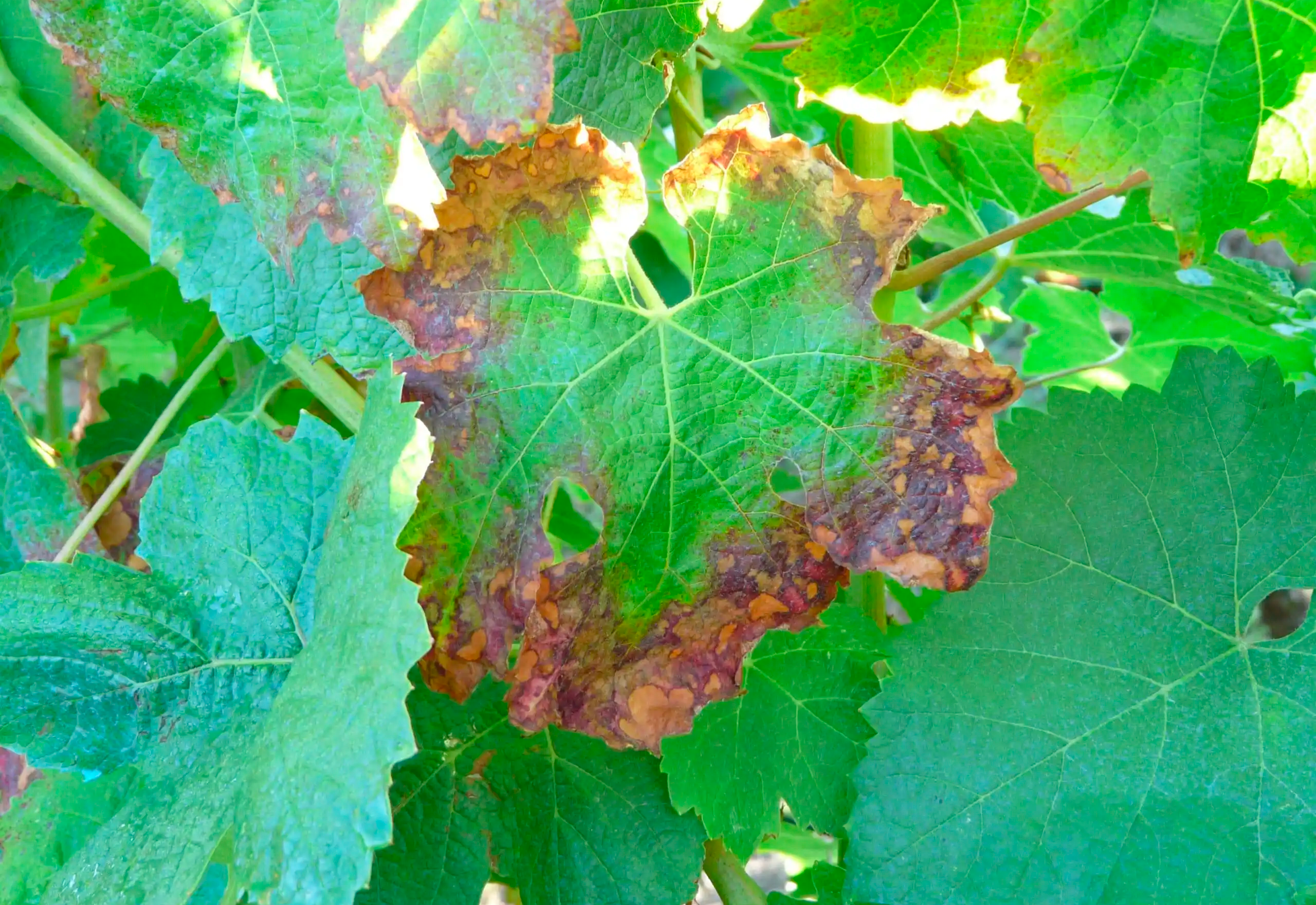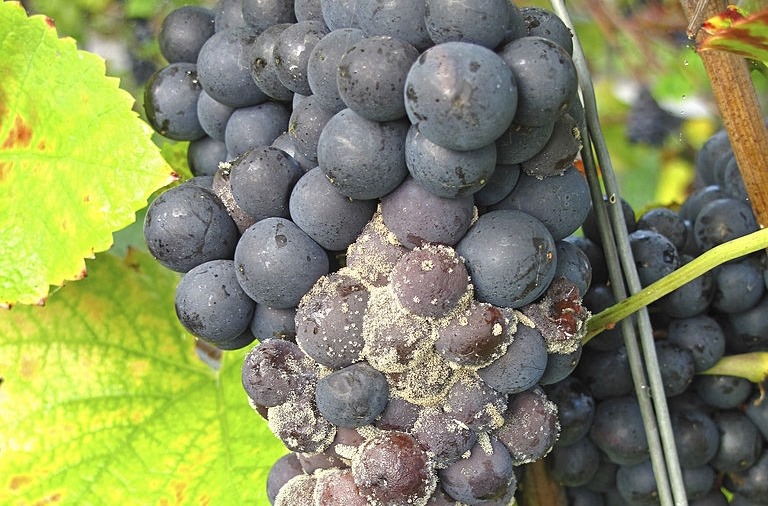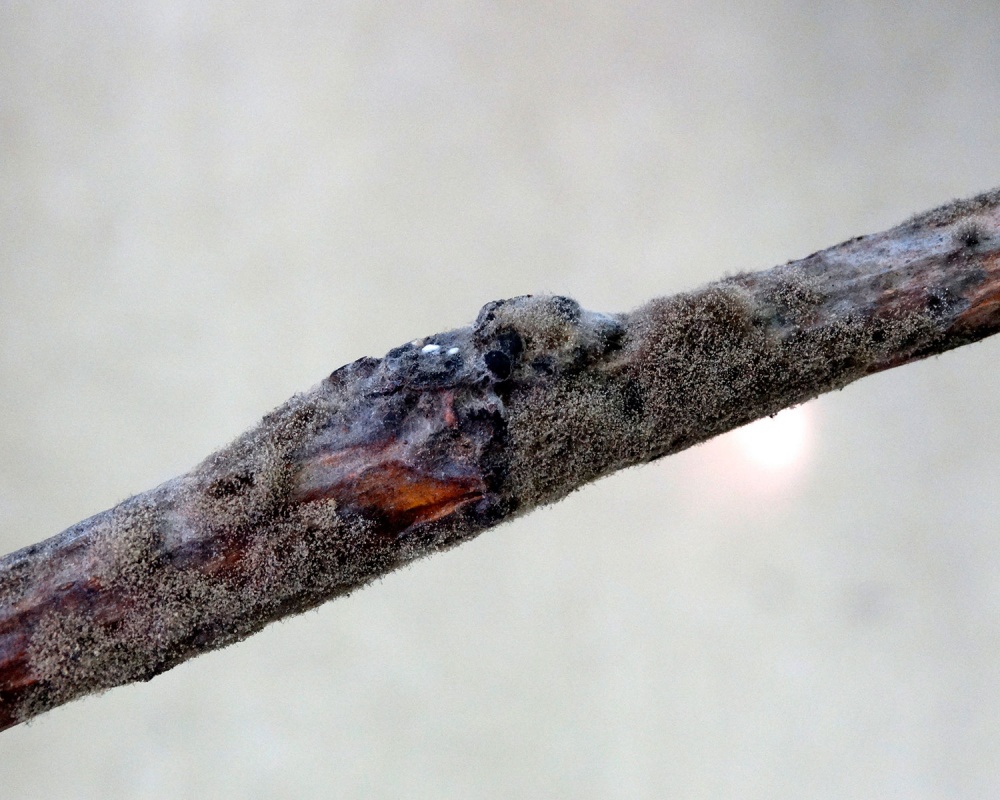
Gray Rot
Botrytis Cinerea
Pathogen:
Fungus
Type:
Risk:
HIGH




DESCRIPTION
Pathogen description
Botrytis cinerea is a filamentous fungus that causes the disease known as gray rot in a wide variety of plants, including crops, flowers and fruit trees. It is a very destructive pathogen that can attack healthy and injured plant tissues, both in field and greenhouse conditions. This fungus spreads rapidly in cool, humid environments, and is capable of surviving for long periods in plant debris, soil, and in storage conditions.
Disease description
On grapevines, Botrytis cinerea can cause a disease known as grape gray rot. Symptoms include the formation of watery Taches on the surface of the berries, which are subsequently covered with grayish mold. As the infection progresses, the berries become soft, wrinkled and eventually disintegrate, leading to loss of harvest and wine quality.

TEMPERATURE AND HUMIDITY
15°C - 20°C
90% - 100%

VOIES DE TRANSMISSION
Air, rainwater, direct contact with infected plants, contaminated soil, contaminated growing tools, infected plant material, and spread through spores produced by the fungus.

Chemical treatments
CONTROL
• AZOXISTROBIN 25% [SC] P/V
• BOSCALIDA 50% [WG] P/P
• CYMOXANIL 4% + FOLPET 33.4% [SC] P/V
• CIPRODINIL 18.75% + TEBUCONAZOLE 12.5% [EC] P/V
• CIPRODINIL 30% [EC] P/V
• CIPRODINIL 37.5% + FLUDIOXONIL 25% [WG] P/P
• DIFENOCONAZOLE 25% [EC] P/V
• EUGENOL 3.3% + GERANIOL 6.6% + THYMOL 6.6% [CS] P/V
• PHENHEXAMIDE 50% [SC] P/V
• PHENHEXAMIDE 50% [WG] P/P
• PHENPIRAZAMINE 50% [WG] P/P
• FLUDIOXONIL 50% [WG] P/P
• FLUOPYRAM 20% + TEBUCONAZOLE 20% [SC] P/V
• FLUOPYRAM 50% [SC] P/V
• FOLPET 50% [SC] P/V
• FOLPET 50% [WP] P/P
• FOLPET 80% [WG] P/P
• POTASSIUM PHOSPHONATES 50.4% (exp. as phosphorous acid) [SL] P/V
• POTASSIUM HYDROGEN CARBONATE 0.425% [AL] P/V
• POTASSIUM HYDROGEN CARBONATE 85% [SP] P/P
• ISOFETAMID 40% [SC] P/V
• LAMINARIN 4.5% [SL] P/S
• MEPANIPIRIM 50% [WP] P/P
• COPPER OXYCHLORIDE 35% (exp. in Cu) [WG] P/P
• TEBUCONAZOLE 20% [EC] P/V
• TEBUCONAZOLE 20% [EW] P/V
• TEBUCONAZOLE 25% [EC] P/V
• TEBUCONAZOLE 25% [EW] P/V
• TEBUCONAZOLE 25% [WG] P/P
• TEBUCONAZOLE 50% + TRIFLOXISTROBIN 25% [WG] P/P
Treatments authorized in organic farming
• EUGENOL 3.3% + GERANIOL 6.6% + THYMOL 6.6% [CS] P/V
• POTASSIUM HYDROGEN CARBONATE 0.425% [AL] P/V
• POTASSIUM HYDROGEN CARBONATE 85% [SP] P/P
• LAMINARIN 4.5% [SL] P/S
• COPPER OXYCHLORIDE 35% (exp. in Cu) [WG] P/P
Biological control
• AUREOBASIDIUM PULLULANS (STRAIN DSM 14940) 50% (2.5
• BACILLUS AMYLOLIQUEFACIENS (strain AH2) (1x10E11 CFU/l) [SC] P/V
• BACILLUS AMYLOLIQUEFACIENS (strain FZB24) 13% [WP] P/P
• BACILLUS AMYLOLIQUEFACIENS (MBI 600 strain) 11% [WP] P/P
• BACILLUS AMYLOLIQUEFACIENS (subsp. plantarum, strain D747) 25% [WG] P/P
• BACILLUS SUBTILIS (strain IAB/BS03) (1 x 10E8 cfu/ml) 10 g/l [SL] P/V
• BACILLUS SUBTILIS (STRAIN QST 713) 1.34% [SC] P/V
• PYTHIUM OLIGANDRUM (strain M1) 17.5% [WP] P/P
• SACCHAROMYCES CEREVISIAE (strain LAS02) 96.1% (1 x 10E13 cfu/Kg) [WG] P/P
• Trichoderma atroviride strain SC1 1(1 x 10E10 cfu)/g [WG] P/P
Preventive treatments
• AZOXISTROBIN 25% [SC] P/V
• BACILLUS AMYLOLIQUEFACIENS (strain AH2) (1x10E11 CFU/l) [SC] P/V
• BACILLUS AMYLOLIQUEFACIENS (strain FZB24) 13% [WP] P/P
• BACILLUS AMYLOLIQUEFACIENS (MBI 600 strain) 11% [WP] P/P
• BACILLUS AMYLOLIQUEFACIENS (subsp. plantarum, strain D747) 25% [WG] P/P
• BACILLUS SUBTILIS (strain IAB/BS03) (1 x 10E8 cfu/ml) 10 g/l [SL] P/V
• BACILLUS SUBTILIS (STRAIN QST 713) 1.34% [SC] P/V
• BOSCALIDA 50% [WG] P/P
• CYMOXANIL 4% + FOLPET 33.4% [SC] P/V
• CIPRODINIL 18.75% + TEBUCONAZOLE 12.5% [EC] P/V
• CIPRODINIL 30% [EC] P/V
• CIPRODINIL 37.5% + FLUDIOXONIL 25% [WG] P/P
• DIFENOCONAZOLE 25% [EC] P/V
• EUGENOL 3.3% + GERANIOL 6.6% + THYMOL 6.6% [CS] P/V
• PHENHEXAMIDE 50% [SC] P/V
• PHENHEXAMIDE 50% [WG] P/P
• PHENPIRAZAMINE 50% [WG] P/P
• FLUOPYRAM 20% + TEBUCONAZOLE 20% [SC] P/V
• FOLPET 50% [SC] P/V
• FOLPET 50% [WP] P/P
• FOLPET 80% [WG] P/P
• POTASSIUM PHOSPHONATES 50.4% (exp. as phosphorous acid) [SL] P/V
• POTASSIUM HYDROGEN CARBONATE 0.425% [AL] P/V
• POTASSIUM HYDROGEN CARBONATE 85% [SP] P/P
• LAMINARIN 4.5% [SL] P/S
• COPPER OXYCHLORIDE 35% (exp. in Cu) [WG] P/P
• PYTHIUM OLIGANDRUM (strain M1) 17.5% [WP] P/P
• TEBUCONAZOLE 20% [EC] P/V
• TEBUCONAZOLE 20% [EW] P/V
• TEBUCONAZOLE 25% [EC] P/V
• TEBUCONAZOLE 25% [EW] P/V
• TEBUCONAZOLE 25% [WG] P/P
• TEBUCONAZOLE 50% + TRIFLOXISTROBIN 25% [WG] P/P
• Trichoderma atroviride strain SC1 1(1 x 10E10 cfu)/g [WG] P/P
To prevent and control gray rot caused by Botrytis cinerea in grapevines, it is essential to implement a series of integrated management measures. These may include appropriate pruning to improve air circulation and reduce humidity, weed control and removal of crop debris. Additionally, preventative fungicides can be applied in a timely manner, especially during periods of high humidity and rain.
Recommendations
*The recommended treatments are recommendations based on the authorities' databases and do not replace in any way the guidelines established by the legislation of each country.





